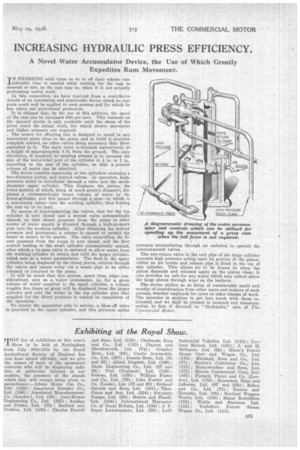INCREASING HYDRAULIC PRESS EFFICIENCY.
Page 49

If you've noticed an error in this article please click here to report it so we can fix it.
A Novel Water Accumulator Device, the Use of Which Greatly Expedites Ram Movement.
IN PRESSING solid tyres on to or off their wheels considerablesiderable time is wasted while waiting for the ram to descend or rise, as the case may be, when it is not actually performing useful work.
In this connection, we have received from a contributor details of an interesting and practicable device which he.suggests could well be applied to such presses and for which he has taken out provisional protection.
It is claimed that, by the use of this addition, the speed of the ram can be increased 500 per cent. This increaae on the upward stroke is only available until the shoes of the press reach the actual work, for which slower movement and higher pressure are required.
The means for effecting this is designed to stand in any convenient place close to the press, and in itself it provides complete control, no other valves being necessary than those embodied in it.The main valve is .Situated conveniently, at a height of approximately 3 ft. from the ground. The only alteration, if required, to existing presses is to increase the size of the water-inlet port of the cylinder to f in. or 1 in., according to the size of the cylinder, so that a greater volume of water can be admitted.
The device consists essentially of two cylinders enclosing a two-diameter piston, and control valves. In operation, highpressure water is introduced through a valve into the smalldiameter upper cylinder. This displaces the piston, the lower portion of which, being of much greater diameter, displaces a correspondingly larger volume of water in the lower .cylinder, and this passes through a pipe—in which is a non-return, valve—into the working cylinder, thus forcing the ram up to its load.
By means of interconnecting the valves, that for the top cylinder is now closed and a second valve automatically opened, so that direct pressure from the pump or other source of water supply is directed through a high-pressure pipe into the working cylinder. After obtaining the desired pressure and movement, a release is opened, to permit the water to return to its source. The valve controlling the direct pressure from the pump is now closed, and the first control leading to the small cylinder automatically opened, after which .a by-pass valve is operated to allow water. from 1.7.1le working cylinder to return and refill the larger cylinder, which acts as a water accumulator. The fluid in the upper cylinder, being displaced by the rising piston, returns through the valves and passes away via a waste pipe to be either released or returned to the pump.
It will be noted that this system, apart from other considerations, acts as a water economizer, as, for a given volume of water supplied to the small cylinder, a volume roughly five times as great will be displaced from the larger cylinder and only the water in the top cylinder plus that supplied for the direct pressure is wasted on completion of the operation.
To render the apparatus safe in service, a blow-off valve is provided in the upper cylinder, and this prevents undue pressure accumulating through an omission to operate the interconnected valves.
The non-return valve in the exit pipe of the large cylinder prevents high pressure acting upon its portion of the piston, whilst an air intake and release pipe is fitted in the top of this cylinder. This allows air to be drawn in when the piston descends and released again as the piston rises; it also provides an exit for any water which may collect above the large piston through wear on the leathers.
The device strikes us as being of considerable merit and worthy of consideration from other users and makers of such presses, whether employed for tyres or other classes of work. The inventor is anxious to get into touch with those interested, and we shall be pleased to forward any commu»i.. ration to him if directed to "Hydraulic," care of The Commercial Motor.




































































































